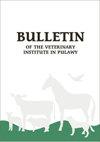Impact of the ageing process on the intensity of post mortem proteolysis and tenderness of beef from crossbreeds
引用次数: 9
Abstract
Abstract The aim of the study was the evaluation of the effect of ageing on the extent of myofibrillar proteins degradation and tenderness of beef in different crossbreeds, BB × HF and SM × HF, from which the musculus semitendinosus was obtained. The pH value, basic composition of meat, and colour parameters were determined on the 3rd d post mortem. The Warner Bratzler shear force and the extent of protein degradation were evaluated in regard to the effect of ageing time. Meat of BB × HF crossbreed had a lower amount of intramuscular fat and higher protein content (P ≤ 0.05). The shear force decreased with ageing time in the case of both crossbreeds. However, the highest values were noted in SM × HF crossbreed on days 3 and 7 of ageing. The differences in proteolysis of myofibrillar proteins and polypeptides, determined by SDS-PAGE electrophoresis, were observed between crossbreeds and the ageing time. A significant decrease in desmin and increased levels of 49-46 kDa and 32-27 kDa polypeptides (products of proteolytic degradation) were observed with an increasing ageing time. In addition, the rate of increase in the amount of 32-27 kDa polypeptides was more significant in BB × HF crossbreed. The data obtained showed that tenderness and the extent of protein degradation are associated with ageing process and animals’ genotype.老化过程对杂交牛肉死后蛋白水解强度和嫩度的影响
摘要本研究旨在评价老化对BB × HF和SM × HF不同杂交品种牛肉肌原纤维蛋白降解程度和嫩度的影响,并由此获得半腱肌。在死后第三天测定肉的pH值、基本成分和颜色参数。考虑老化时间的影响,评估了华纳-布拉茨勒剪切力和蛋白质降解程度。BB × HF杂交种肉的肌内脂肪含量较低,蛋白质含量较高(P≤0.05)。两种杂交品种的剪切力随老化时间的延长而减小。而SM × HF杂交品种在老化后第3天和第7天最高。通过SDS-PAGE电泳,观察了不同杂交品种的肌纤维蛋白和多肽蛋白水解的差异。随着衰老时间的延长,desmin显著减少,49-46 kDa和32-27 kDa多肽(蛋白水解降解产物)水平升高。此外,32-27 kDa多肽数量在BB × HF杂交中增加的速率更为显著。获得的数据表明,嫩度和蛋白质降解程度与衰老过程和动物的基因型有关。
本文章由计算机程序翻译,如有差异,请以英文原文为准。
求助全文
约1分钟内获得全文
求助全文

 求助内容:
求助内容: 应助结果提醒方式:
应助结果提醒方式:


